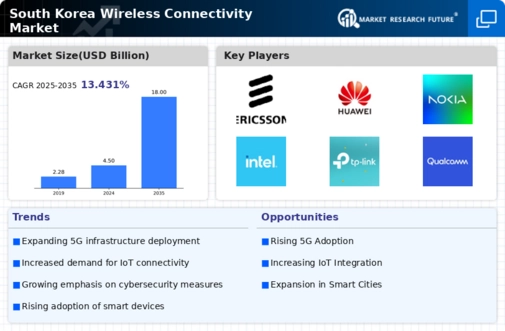Surge in Mobile Data Consumption
The wireless connectivity market in South Korea experiences a notable surge in mobile data consumption, driven by the increasing reliance on smartphones and mobile applications. As of 2025, mobile data traffic is projected to reach approximately 5.5 exabytes per month, reflecting a growth rate of around 30% annually. This trend indicates a shift towards data-intensive applications such as video streaming, online gaming, and social media, which require robust wireless connectivity. Consequently, service providers are compelled to enhance their network infrastructure to accommodate this demand, thereby fostering growth within the wireless connectivity market. The competitive landscape further intensifies as companies strive to offer superior data services, leading to innovations in technology and service delivery.
Government Initiatives and Investments
The South Korean government plays a pivotal role in shaping the wireless connectivity market through various initiatives and investments. With a commitment to advancing digital infrastructure, the government has allocated substantial funding, estimated at $2 billion, to support the expansion of wireless networks, particularly in rural areas. This investment aims to bridge the digital divide and ensure equitable access to high-speed internet services. Additionally, regulatory frameworks are being established to facilitate the deployment of next-generation technologies, which are expected to enhance connectivity and drive economic growth. Such proactive measures by the government not only stimulate market growth but also encourage private sector participation in the wireless connectivity market.
Rising Demand for Smart City Solutions
The wireless connectivity market in South Korea is significantly influenced by the rising demand for smart city solutions. As urbanization accelerates, cities are increasingly adopting technologies that enhance efficiency and sustainability. The integration of IoT devices, smart traffic management systems, and public safety solutions necessitates robust wireless connectivity. By 2025, it is anticipated that investments in smart city projects will exceed $10 billion, creating a substantial demand for advanced wireless infrastructure. This trend underscores the importance of reliable connectivity in supporting the seamless operation of smart city initiatives, thereby propelling growth in the wireless connectivity market. Stakeholders are likely to collaborate to develop innovative solutions that address urban challenges through enhanced connectivity.
Increased Focus on Cybersecurity Measures
As the wireless connectivity market in South Korea expands, there is an increased focus on cybersecurity measures to protect sensitive data and maintain user trust. With the proliferation of connected devices and the rise of cyber threats, stakeholders are prioritizing the implementation of robust security protocols. By 2025, it is estimated that spending on cybersecurity solutions in the telecommunications sector will reach $1.5 billion, reflecting a growing recognition of the importance of safeguarding networks. This emphasis on cybersecurity not only enhances the overall reliability of wireless services but also fosters consumer confidence in adopting new technologies. Consequently, the wireless connectivity market is likely to benefit from these enhanced security measures, which are essential for sustaining growth.
Emergence of Advanced Wireless Technologies
The emergence of advanced wireless technologies, such as Wi-Fi 6 and future iterations, is poised to transform the wireless connectivity market in South Korea. These technologies offer improved speed, capacity, and efficiency, catering to the growing needs of consumers and businesses alike. As of November 2025, the adoption rate of Wi-Fi 6 is projected to reach 40% among households, driven by the increasing number of connected devices. This shift not only enhances user experience but also supports the proliferation of smart home applications and enterprise solutions. The competitive dynamics within the wireless connectivity market are likely to evolve as companies invest in these advanced technologies to differentiate their offerings and capture market share.



















Leave a Comment